Punjab State Board PSEB 7th Class Maths Book Solutions Chapter 10 Practical Geometry Ex 10.3 Textbook Exercise Questions and Answers.
PSEB Solutions for Class 7 Maths Chapter 10 Practical Geometry Ex 10.3
1. Construct ΔABC such that AB = 4 cm, ∠B = 30°, BC = 4 cm. Also name the type of triangle on the basis of sides.
Solution:
Given : Two sides of ΔABC as AB = 4 cm, BC = 4 cm and ∠B = 30°.
To construct: A triangle with these two sides and included angle.
Step of Construction :
Step 1. We first draw a rough sketch of the ΔABC and indicate the measure of these two sides and included angle.
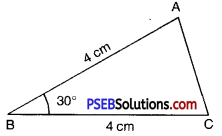
Step 2. Draw a line segment BC of length 4 cm.
![]()
Step 3. At B draw BX making an angle of 30° with BC (The point A must be somewhere on this ray of the angle).

Step 4. (To fix A, the distance AB has been given) With B as centre, draw an arc of radius 3 cm. It cuts BX at the point A.

Step 5. Join AC.
ΔDEF is now obtained.
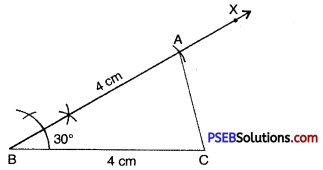
Since two sides of triangle are equal.
Therefore ΔABC is an isosceles triangle.
![]()
2. Construct ΔABC with AB = 7.5 cm, BC = 5 cm and ∠B = 30°.
Solution:
Given. Two sides of ΔABC as AB = 7.5 cm,
BC = 5 cm
and ∠B = 30°
To construct A triangle with these two sides and included angle.
Steps of Construction.
Step 1. We first draw a rough sketch of the ΔABC and indicate the measures of these two sides and included angle.
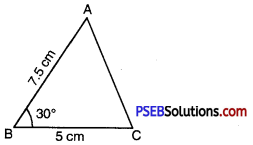
Step 2. Draw a line segment BC of length 5 cm.
![]()
Step 3. At B draw BX making an angle of 30° with BC. (The point A must be somewhere on this ray of the angle)
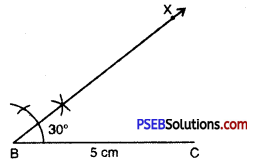
Step 4. (To fix A; the distance BC has been given) With B as centre draw an arc of radius 7.5 cm. It cuts CX at the point A.
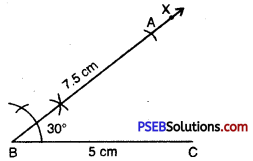
Step 5 : Join AC.
ΔABC is now obtained.
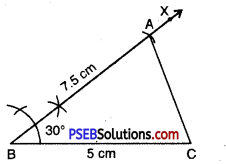
![]()
3. Construct a triangle XYZ, such that XY = 6 cm, YZ = 6 cm and ∠Y = 60°. Also name the type of this triangle.
Solution:
Step 1. Draw a rough sketch of XYZ with given measures.
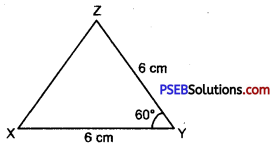
Step 2. Draw a line segment XY of length 6 cm.
![]()
Step 3. With the help of compass, at Y, draw a ray YA making an angle 60°
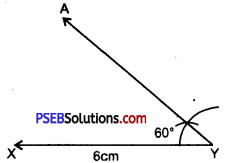
Step 4. With Y as centre and radius 6 cm. draw an arc intersecting the ray YX at point Z.
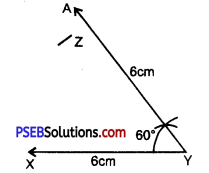
Step 5. Join XZ.ΔXYZ is required triangle, Measure the third side. We see that ZX = 6 cm
∴ In Δ XYZ
XY = YZ = ZX = 6 cm
Therefore XYZ is an equilateral triangle.
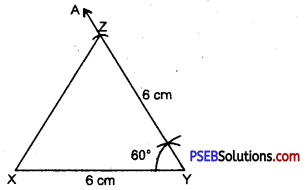
![]()
4. Which of the following triangle can be constructed using SAS criterion.
(a) AB = 5 cm, BC = 5 cm, CA = 6 cm
(b) AB = 5 cm, BC = -5 cm, ∠B = 40°
(c) ∠A = 60°, ∠B = 60°, ∠C = 60°
(d) BC = 5 cm, ∠B = ∠C = 45°
Answer:
(b) AB = 5 cm, BC = -5 cm, ∠B = 40°
